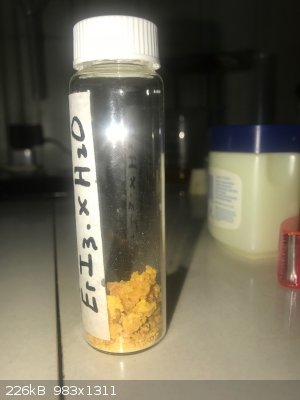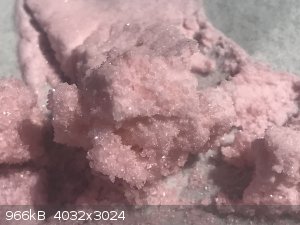Lion850
National Hazard
   
Posts: 514
Registered: 7-10-2019
Location: Australia
Member Is Offline
Mood: Great
|
|
Report on making Erbium Iodide
Not sure why my earlier attempts to post this messed up and seemed to duplicate themselves? Now shortened.
4 gram Erbium pieces and 2g Iodine was placed in 150ml dichloromethane and stirred. No reaction after 2 hours, abandoned. Xylene was tried next. After
a few hours there was no sign of reaction and it was abandoned.
Ethanol was tried next. After a few hours there was no sign of iodine consumption so it was stopped. However, when I washed the erbium pieces with
water afterwards they started to bubble with cold water. I thought erbium should do this only with hot water so maybe the iodine did react (slowly)
with the erbium in ethanol, enough to activate it.
I don’t have any HI so that method was not an option. So I started thinking about double displacement. Calcium, barium, or strontium iodides would
have been a good starting point because these are very soluble while their sulfates are insoluble, but I did not have any of these. The only option
was lead iodide.
Lead iodide is very slightly soluble in cold water and a bit more in hot water, while lead sulfate is just about insoluble. So I needed erbium sulfate
to try the double displacement with lead iodide (but I realised afterwards the chloride may have worked and this would have made things simpler….)
There is a bit of data regarding the solubility of erbium sulfate on Wikipedia, but it does not seem very accurate. From my experience it seems to be
slightly soluble in cold water and almost not at all in hot water.
I added erbium sulfate to 800ml of water in a beaker and stirred, slowly adding until the ppt that formed did not seem to want to dissolve any more. I
then increased the water to 900ml and added a bit more erbium sulfate giving a very small ppt.
I then added 6g lead iodide and got a yellow solution. This was left to stir overnight plus the next day. After some 24 hrs the color was pale yellow
with some white ppt, and then added another 6g lead iodide and stirred another 18 hours or so. After this I had more white ppt and the bright yellow
color was gone. It was very pale yellow-golden, see photo. The solution was filtered. The white ppt was washed and dried and placed in a vial as lead
sulfate. The golden solution was boiled down. As the volume decreased, pink erbium sulfate precipitated out, and the solution was hot filtered each
time it was transferred to a small beaker.
When it was down to 20ml it was poured into a crucible and into the sand bath. Sand temperature was just under 200C and the solution was very slowly
boiling away. Eventually it was very sticky and the edges that was dried out was changing color. No iodine fumes were observed and no smell, seemed
only steam coming off. I thought it could be boiling off its water of hydration and removed the crucible from the heat. Conveniently, the very small
quantity of erbium sulfate still present made its way to the edge of the hot syrup so that was easy to remove with a spatula. I then kept stirring the
solution while it cooled. It became rock hard pieces with yellow-red color (for some reason the red is not showing up well in photos). The quantity in
the vial is 10.5g.
The small pieces still in the crucible was very hygroscopic. Once they cooled they quickly became wet from atmospheric moisture. I added a small bit
of water and they very quickly dissolved. A few drops of lead nitrate solution was added the bright yellow ppt confirmed the presence of a soluble
iodide.
Happy that I managed to get to ErI3.xH2O! But the method is very inefficient. I have a few idea how to do it (very) different next time. Ideally using
a different iodide (not lead) and possible erbium chloride instead of sulfate.

|
|
|
Lion850
National Hazard
   
Posts: 514
Registered: 7-10-2019
Location: Australia
Member Is Offline
Mood: Great
|
|
I had details about making the erbium sulfate in the original draft but maybe it was too long as it messed up when I tried to post. Also had more
photos. I think I unintentionally made anhydrous erbium sulfate which was interesting and I will try to duplicate that and report in a separate post.
|
|
|
woelen
Super Administrator
        
Posts: 7977
Registered: 20-8-2005
Location: Netherlands
Member Is Offline
Mood: interested
|
|
Lion850, great respect for your results and how you manage to handle such large volumes of very dilute solutions 
You call this methid inefficient. Maybe it is in terms of time and energy, but the result is there and you have an interesting sample for your
collection.
Keep up the good work! I very much enjoy your iodides-series!
|
|
|
Tsjerk
International Hazard
    
Posts: 3022
Registered: 20-4-2005
Location: Netherlands
Member Is Offline
Mood: Mood
|
|
Very nice indeed, now I wonder how you made the sulfate.. I really like your series as well.
|
|
|
Lion850
National Hazard
   
Posts: 514
Registered: 7-10-2019
Location: Australia
Member Is Offline
Mood: Great
|
|
Making the sulfate is a story in itself which I did include in the original draft of my report but it got so long it would not post.
I started with erbium oxide, which was obtained from a pottery supplier. Nice pink powder. I reacted 10g of the oxide with 8ml of concentrated
sulphuric diluted to 16ml. Initially there was a vigorous reaction but this soon stopped. I added a bit more acid but there was no further reaction. I
added extra amounts of oxide and acid but there was not much happening. I was not sure whether the pink ppt was now the sulfate or still the oxide as
they look very similar. I added a bit more oxide but nothing happened. I then increased the water to 300ml and stirred quite a while, filtered, and
had a pink solution but still also a lot of ppt.
This sulfate solution was used for my first attempt, the one that spilled. When I did it the second time I realised I had to be sure I have sulfate
and not a substantial amount of oxide. I added hydrochloric acid (50% diluted) in excess to the washed pink ppt from the first attempt to make the
sulfate using H2SO4. Reasoning was that the HCl should dissolve any oxide but not affect the sulfate. There was indeed substantial bubbling and I got
a goldish solution with now less pink ppt. The gold solution was filtered off, it was about 150ml. The pink ppt was washed and considered to be
sulfate.
I needed more sulfate but wanted to use another method. At this point I also realised the sulfate was only sparingly soluble in water at room temp and
even much less near boiling temp. I dissolved 35g copper sulfate in 100ml water, and mixed that with the erbium chloride with both heated to boiling.
I got a dark green solution.....with a white ppt! I was expecting pink. And when this solution boiled, the steam was pink! The pink color in the steam
must have been finely divided erbium sulfate being carried off in the steam? But the why the white ppt?
I decantered off the dark green (copper chloride) solution. Left was the still very hot white ppt with some green spots. I decided to wash the ppt
with cold water by decantation. And added cold water...at which point the ppt immediately became pink (seemed instantaneous) and the solution blue
from excess copper sulfate. The pink ppt was washed and regarded as erbium sulfate. As a test I mixed some with HCl but there was no reaction, thus
proving it was not the oxide.
Doing the copper sulfate and erbium chloride double displacement with near boiling water must have resulted in anhydrous erbium sulfate, as the
sulfate is so sparingly soluble in hot water. Thus the white color. I plan at some stage to do this double displacement again, but to then wash the
while ppt with boiling water before drying to see if I can obtain dry anhydrous erbium sulfate.
I suspect the sulphuric acid did not react with all the oxide in the first attempt to make the sulfate because there was not enough water to dissolve
all the formed sulfate. Maybe excessive stirring would have resulted in a better yield. I'm glad it did not, else I would not have seen the
interesting double displacement reaction. Photo of erbium sulfate crystals attached.

|
|
|
woelen
Super Administrator
        
Posts: 7977
Registered: 20-8-2005
Location: Netherlands
Member Is Offline
Mood: interested
|
|
If I were you, I would buy some Na2SO4 and use that for this reaction. With copper sulfate you introdoce copper ions, which are not pleasant when they
contaminate your final product. having sodium ions as impurity in your product is not a real issue in most experiments, while having copper ions can
spoil many interesting experiments (e.g. copper forms strongly colored complexes with many molecules and anions).
I myself have stocks of Na2SO4, K2SO4, NaCl (reagent, not table salt), KCl, NaNO3 and KNO3 (not fertilizer grade, but reagent), just for this purpose
of sometimes being able to add extra anions of one of the most common types, without adding a special cationic species. These chemicals are cheap,
easy on storage and easy to obtain.
|
|
|
Bezaleel
Hazard to Others
  
Posts: 444
Registered: 28-2-2009
Member Is Offline
Mood: transitional
|
|
You erbium sulphate looks good! And thanks for posting your method here.
An few years back, I made some erbium sulphate also and I noticed the same as you: in hot solutions it is almost insoluble, and comes out as a
(nearly) white substance. At low temperature, it is slightly soluble. I did not continue with erbium sulphate, because the substance is not soluble
enough to grow nice crystals from.
Coincidentally, I tried to make erbium formate yesterday, using 2cm of 85% formic acid in a test tube with half a spatula of erbium oxide (pottery
grade). This did not dissolve, neither after 10 minutes of boiling and neither after dilution to ~30%. Addition of a bit of sodium chloride made the
oxide dissolve by boiling the solution for about 10 minutes. The pink solution is slightly turbid, which I attribute to tiny particles of undissolved
Er2O3. (Further heating did not yield a clear solution. Maybe I should try under reflux.)
|
|
|
Lion850
National Hazard
   
Posts: 514
Registered: 7-10-2019
Location: Australia
Member Is Offline
Mood: Great
|
|
Hi Woelen - thanks for the tip. I did not think about this. The reason I like using copper sulfate is because I get an interesting by-product (copper
chloride) and the colors can give some indication of which compound is in excess in the reaction.
|
|
|